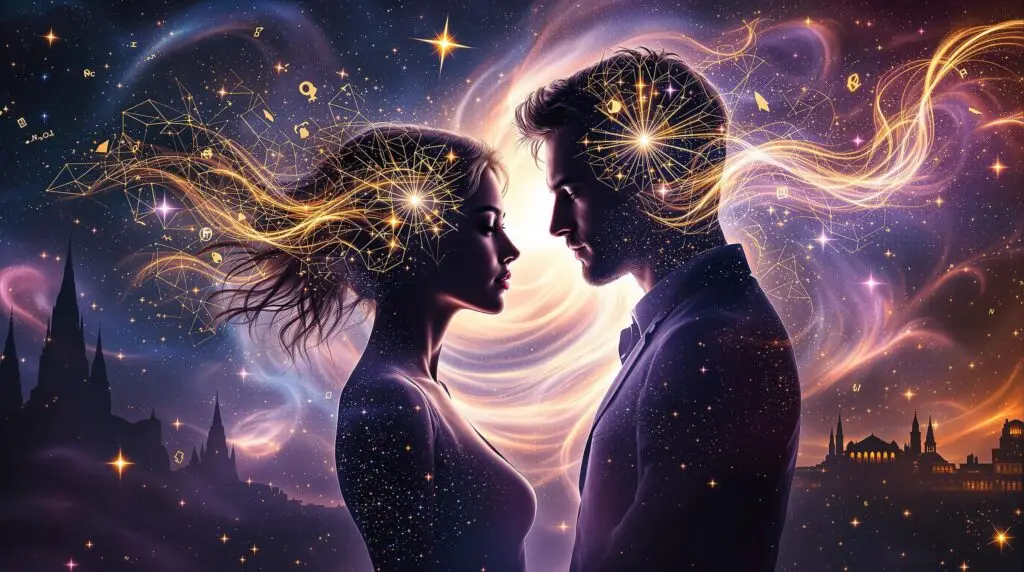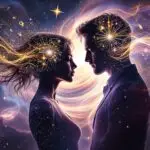According to GfK Entertainment and NielsenIQ BookData, science fiction and fantasy book sales increased by 41.3% between 2023 and 2024, with romance novels and fantasy titles performing particularly well. This surge reflects readers’ growing appetite for stories that blend emotional depth with imaginative possibilities—exactly what romantic science fiction delivers.
In The Convergence Series, love isn’t just an emotional subplot—it’s the key to restoring a fractured universe. Samantha and Connor’s relationship reflects the series’ core theme: unity creates strength, even on a cosmic scale. As their connection deepens, reality itself begins to heal, showing that love can be as powerful as any magical or technological force.
Key Takeaways
- Cosmic healing requires both analytical precision and creative intuition, demonstrated through Samantha and Connor’s complementary approaches to unified consciousness
- Individual identity strengthens rather than diminishes when two people choose partnership over mystical compulsion in romantic science fiction narratives
- Reality distortions serve as metaphors for relationship challenges, showing how artificial separation creates instability that only cooperation can resolve
- Institutional conflicts between families and organizations mirror the tension between personal autonomy and collective responsibility in love stories
- Dynamic equilibrium represents the ultimate goal—sustainable balance that honors both individual growth and unified purpose in romantic relationships
When Love Becomes a Force of Nature
The romantic science fiction genre has experienced remarkable growth, with fantasy book sales up 62% through the first nine months of 2024, according to Publishers Weekly. This trend reflects readers’ desire for stories where emotional connections drive cosmic-scale events.
The Convergence: Restoration exemplifies this appeal by making Samantha and Connor’s relationship integral to universal healing. Their love story transcends typical romantic conventions because their emotional bond directly affects reality’s stability. When they first meet at the Academy Memorial Gardens, their physical contact triggers unified magical effects that stabilize reality distortions—proving that their connection operates on both personal and cosmic levels.
This approach to romantic science fiction resonates with modern readers who seek stories where love enhances rather than diminishes individual capability. Science fiction romance authors note that the best stories in this genre show how romantic partnerships can amplify each character’s unique strengths rather than requiring them to abandon their essential nature.
The Engineer Meets Artist Dynamic
Samantha Reed represents analytical thinking applied to magical phenomena, while Connor Blake embodies creative intuition translated into cosmic-scale effects. Their relationship demonstrates what makes romantic science fiction particularly compelling: the exploration of how different approaches to problem-solving can create powerful synergy.
As Barnes & Noble’s romance experts observe, “Science fiction is a terrific genre for exploring concepts and ideas that may change our lives. Romance is a terrific genre for exploring our inner, emotional selves and our quest for community.” The Samantha-Connor partnership embodies this fusion perfectly.
Samantha’s engineering background provides technical frameworks for understanding unified consciousness, while Connor’s artistic vision creates practical applications for cosmic-scale restoration. Their complementary skills reflect romantic science fiction’s core appeal: showing how love can bridge seemingly incompatible worldviews to create something neither person could achieve alone.
This dynamic particularly appeals to the genre’s growing audience of educated professionals. Recent market analysis shows that romantic science fiction attracts readers who value both intellectual engagement and emotional satisfaction—exactly the combination Samantha and Connor’s relationship provides.
Reincarnated Souls and Conscious Choice
The series tackles one of romantic science fiction’s most fascinating possibilities: what happens when cosmic forces bring people together across lifetimes? Rather than treating reincarnation as romantic destiny that eliminates personal agency, The Convergence explores how inherited connection can enhance rather than override individual choice.
Samantha and Connor discover they’re reincarnated souls of historical figures who sacrificed themselves 150 years ago to preserve reality during a catastrophic event called the Sundering. However, their current relationship develops through conscious decisions based on who they are now, not who they once were.
This nuanced approach addresses what science fiction romance readers particularly value: stories that honor both mystical connection and personal autonomy. As bestselling author Natasha Pulley notes, the best romantic science fiction “showcase[s] relationships that are either not in existence yet in our current world, or very unusual, and put[s] them in a context where they’re completely normal.”
The series demonstrates that even cosmic-scale love requires ongoing choice. Samantha and Connor choose each other repeatedly throughout their journey—when they first meet, when they accept their historical mission, and when they complete the restoration process. Their relationship succeeds because it honors both inherited connection and individual growth.
Academic Politics Meet Cosmic Stakes
The institutional conflict between the Academy, the Williams organization, and independent researchers provides the perfect backdrop for exploring how personal relationships navigate larger social forces. This reflects romantic science fiction’s ability to examine intimate connections within epic contexts.
Margaret Carter’s family has preserved hidden knowledge about the original Restoration for generations, while the Williams organization has prepared for five generations to eliminate unified consciousness practitioners they view as cosmic threats. These institutional tensions mirror the personal challenges Samantha and Connor face in building their relationship.
Romance market data shows that certain niche genres—particularly those featuring institutional settings and complex worldbuilding—tend to perform exceptionally well with dedicated readerbases. The academic and emergency response elements in The Convergence provide realistic grounding for magical concepts while creating familiar settings that professional readers can connect with.
The series’ institutional conflicts also demonstrate how romantic science fiction can explore contemporary themes through futuristic lenses. Questions about individual rights versus collective security, institutional authority versus evidence-based adaptation, and traditional doctrine versus emerging realities all resonate with current social discussions while being examined through the lens of cosmic-scale magical politics.
Reality Distortions as Relationship Metaphors
One of the most innovative aspects of The Convergence series is how it uses reality distortions as both plot devices and metaphors for relationship challenges. When artificial separation has been maintained too long, reality itself begins to fracture—requiring healing that can only come through balanced cooperation.
This concept reflects what makes romantic science fiction uniquely powerful: its ability to externalize internal emotional dynamics through speculative elements. Samantha and Connor’s growing connection literally stabilizes reality distortions, showing how healthy relationships can create stability in chaotic circumstances.
Expert analysis of science fiction romance reveals that readers are drawn to stories where “the events of our lives don’t happen in a vacuum! Our love lives are heavily influenced by everything we do in life, and vice versa.” The Convergence series exemplifies this integration by making the romantic relationship inseparable from cosmic-scale events.
The series also demonstrates how romantic partnerships can address systemic problems that individual effort cannot solve. Reality distortions affect entire populations, but conventional methods fail where Samantha and Connor’s cooperative approach succeeds. Their relationship becomes a model for addressing collective challenges through balanced integration rather than forced solutions.
The Williams Organization: When Love Faces Zealous Opposition
Commander Varis represents romantic science fiction’s classic obstacle: the antagonist whose personal trauma has crystallized into institutional zealotry that cannot adapt to changing circumstances. His absolute commitment to eliminating unified consciousness creates immediate physical danger while forcing Samantha and Connor to accelerate their relationship development under pressure.
This dynamic reflects what science fiction romance readers find compelling about the genre: the way external threats can intensify romantic connections while testing whether love can survive ultimate challenges. When faced with weapons designed to eliminate unified souls permanently, Samantha and Connor must choose between personal safety and cosmic responsibility.
The Williams organization’s internal division between moderate and extreme factions also provides a nuanced examination of how institutions can evolve. Devin Williams represents the possibility for evidence-based adaptation, while Varis embodies rigid adherence to outdated doctrine. This institutional conflict parallels the relationship dynamics between characters who must choose cooperation over conflict.
The series’ resolution of the Williams threat demonstrates romantic science fiction’s optimistic potential: showing how love can transform even zealous opposition into resources for positive change. The superweapon designed to destroy unified consciousness becomes integral to the restoration process when approached through balanced frameworks that honor both separation and unity.
Dynamic Equilibrium: A New Model for Romantic Science Fiction
The series’ conclusion establishes what could become a new paradigm for romantic science fiction: dynamic equilibrium that honors both individual autonomy and unified purpose. Rather than requiring either complete merger or total separation, Samantha and Connor achieve integration that allows them to function as both separate individuals and unified consciousness.
This resolution addresses persistent questions in romantic science fiction about whether cosmic-scale love requires personal sacrifice. Current publishing trends show readers increasingly seek “contemporary stories tackling real-life issues like mental health, personal growth, and the complexities of modern relationships.” The Convergence model provides a framework for exploring these themes within speculative contexts.
The dynamic equilibrium concept also suggests expansion possibilities for romantic science fiction as a genre. If balanced integration can work for cosmic-scale healing, similar principles might apply to other dimensional matrices facing artificial separation problems. This creates potential for stories that honor universal principles while respecting local cultural variations.
Most importantly, the series demonstrates that sustainable romantic relationships can enhance rather than constrain individual authenticity. Samantha maintains her analytical engineering approach while gaining access to artistic intuition. Connor preserves his creative vision while incorporating systematic thinking. Their partnership proves that the best romantic science fiction shows love as growth catalyst rather than identity merger.
FAQ
What makes romantic science fiction different from regular romance novels?
Romantic science fiction places love stories within speculative contexts that allow exploration of relationships unconstrained by current social reality. According to romance experts, the genre’s unique appeal lies in “its ability to combine the thrilling aspects of science fiction with the emotional depth of romance,” creating stories that engage both hearts and minds. The futuristic or technologically advanced settings provide frameworks for examining romantic dynamics that might not be possible in contemporary contexts.
How does The Convergence series avoid the “fated mates” trope while still using reincarnated souls?
The series distinguishes between mystical recognition and conscious choice by having Samantha and Connor choose their relationship based on who they are in their current incarnation rather than their inherited connection. While they carry consciousness patterns from previous lives, their romantic development occurs through present-day decisions, shared experiences, and compatible personalities. This approach honors both cosmic connection and individual agency—showing that even destiny requires ongoing choice to become meaningful relationship.
Why are engineer protagonists rare in romantic science fiction?
Market research indicates that romantic science fiction has traditionally focused on space opera adventures or paranormal elements rather than technical professions. Engineering protagonists require authors to balance analytical thinking with emotional development in ways that respect both scientific methodology and romantic storytelling. Samantha Reed’s character demonstrates how technical expertise can enhance rather than inhibit romantic development when integrated thoughtfully into speculative contexts.
What role do institutional conflicts play in romantic science fiction?
Institutional opposition provides external pressure that can accelerate romantic development while exploring broader themes about individual rights versus collective authority. Science fiction romance authors note that the best stories in the genre use futuristic settings to examine contemporary social tensions through speculative lenses. The Academy-Williams conflict in The Convergence series allows exploration of evidence-based adaptation versus traditional doctrine while creating obstacles that test whether love can survive ultimate challenges.
The Convergence Series
The Convergence series offers romantic science fiction readers everything they crave: intelligent protagonists who maintain their professional competence while falling in love, cosmic stakes that make every emotional choice matter, and relationships that prove love can heal reality itself.
Both books in the series can be enjoyed as standalone adventures or read together for the complete experience. Whether you start with Broken Magic or dive directly into Restoration, you’ll discover romantic science fiction that respects both your analytical mind and your desire for emotional depth.
Broken Magic introduces the world where artificial separation of magic creates mounting instabilities, while Restoration follows Samantha and Connor’s story as they discover their connection to cosmic-scale healing. Each book delivers complete character arcs and satisfying romantic conclusions while contributing to the larger narrative of reality’s restoration.
If you’ve been searching for romantic science fiction that features engineer protagonists, complementary problem-solving approaches, and love stories where partnership amplifies rather than diminishes individual strength, The Convergence series delivers the perfect synthesis. This isn’t just another enemies-to-lovers romance—it’s an exploration of how different approaches to problem-solving can create partnerships powerful enough to restore universal balance.
For readers who loved the political complexity of The Priory of the Orange Tree, the hidden history elements of The Ten Thousand Doors of January, and the character development depth of The Invisible Life of Addie LaRue, The Convergence series provides the next evolution in romantic science fiction: stories where love becomes the ultimate technology for healing fractured realities.
Ready to experience romantic science fiction that proves the most profound solutions require both hearts and minds working in perfect harmony?
Start your journey with Broken Magic or jump directly into Restoration—both available now on Amazon.






